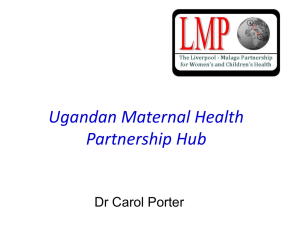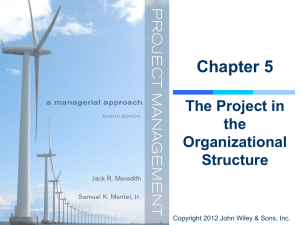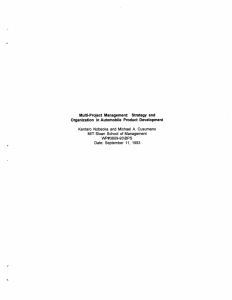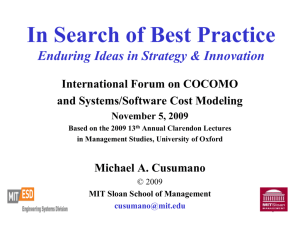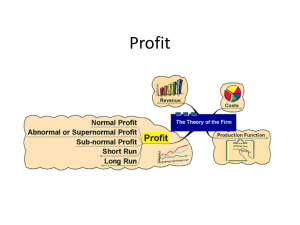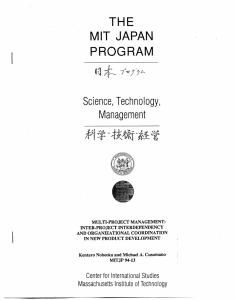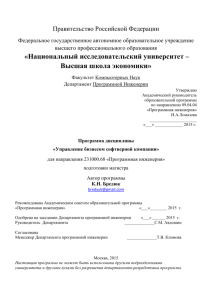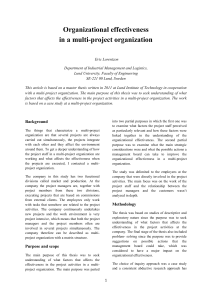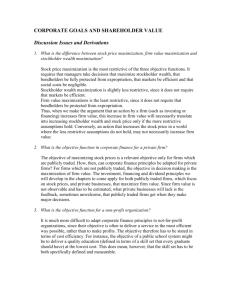Document 11014408
advertisement
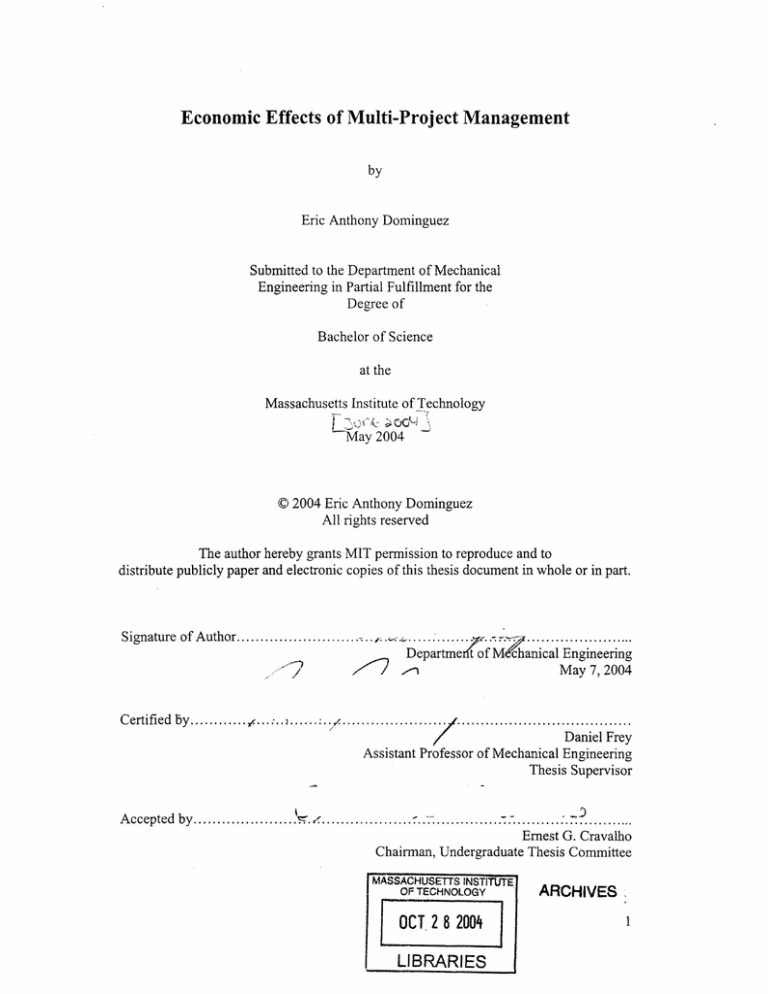
Economic Effects of Multi-Project Management by Eric Anthony Dominguez Submitted to the Department of Mechanical Engineering in Partial Fulfillment for the Degree of Bachelor of Science at the Massachusetts Institute of Technology May 2004 © 2004 Eric Anthony Dominguez All rights reserved The author hereby grants MIT permission to reproduce and to distribute publicly paper and electronic copies of this thesis document in whole or in part. SignatureofAuthor.............................. -'...-. .. Departm ?.,/ ...... Certified by ................ e ..- n / ............ cchanical Engineering ay7, 2004 yM :... ...... ................... Daniel Frey Assistant Professor of Mechanical Engineering Thesis Supervisor Accepted by. A ccepted by .. ........... ... °. Y. r ....... ........... ............... ................... . ..... ....... Ernest G. Cravalho Chainrman, Undergraduate Thesis Committee MASSACHUSETTS"INS t OF TECHNOLOGY II NaT n ., 4 2 DCnrT2 L R MMn IBRARIES - LIBRARIES E. ARCHIVES I Economic Effects of Multi-Project Management by Eric Anthony Dominguez Submitted to the Department of Mechanical Engineering on May 7, 2004 in partial fulfillment of the requirements for the Degree of Bachelor of Science in Mechanical Engineering ABSTRACT This thesis discusses various approaches to project management. In particular, it focuses on the effects of functional and project coordination when inter-project interactions exist. Various organizational structures and their corresponding advantages and disadvantages are first presented. The effects of theses organizational structures on projects with and without inter-project interactions are then studied. Next, difficulties that may arise from combining various management structures with profit maximization are analyzed. Finally, it is shown that by managing inter-project interactions effectively, rapid design transfer is achievable. This allows both quick product development and relatively new design in products, while requiring limited financial and organizational resources. Thesis Supervisor: Daniel Frey Title: Assistant Professor of Mechanical Engineering 2 Table of Contents Table of Contents...................................................................................... 3 List of Figures......................................................................................... 4 List of Tables.......................................................................................... 5 1.0 Introduction ....................................................................................... 6 2.0 Multi-Project Management ..................................................................... 6 2.1 Organizational Structure .................................................................... 6 2.1.1 Functional Orientation ............................................................... 8 2.1.2 Product Orientation .................................................................. 10 2.1.3 Matrix Organization ............................................................... 11 2.2 Hypothesis on How Inter-project Interactions Effect Organizational Structures.. 14 2.3 Observed Effects of Inter-project Interactions .......................................... 16 3.0 Profit Maximization ............................................................................ 17 4.0 Combining Multi-project Management and Profit Maximization ........................ 20 5.0 Typology of Inter-Project Strategy ........................................................... 22 6.0 Conclusion ....................................................................................... 25 3 List of Figures 8 Figure 1: General Matrix-organization Model .................................................................... Figure 2: A functional structure with authority concentrated in functional managers.......9 Figure 3: A lightweight product manager structure in which product managers exist but have little authority in comparison with the functional manager ....... 10 Figure 4: Influences of Inter-project Interactions on the Degree of Coordination Requirements ..................................................................................................... 14 Figure 5: Impact or Task Interdependency on Organization .................................. 15 Figure 6: Typology of the Inter-Project Strategy ................................................ 23 4 List of Tables Table 1: Types of Interactions ..................................................................... 15 5 1.0 Introduction Optimal design of a system must be able to quickly respond to short and long term conditions. Several different approaches are available to obtain this goal. Microeconomists use the assumption that firms typically attempt to maximize long-run profits in order to stay competitive, but acknowledge that certain factors of production are fixed in the short-run. On the other hand, managers understand that each project within a firm has at least some linkages, both technologically and organizationally, with other on-going projects and past projects within the firm. With this knowledge, they attempt to leverage their engineering and financial resources across as many projects as possible. The purpose of this research project is to explore the various approaches used by engineering firms to optimize resources. 2.0 Multi-Project Management This section will discuss various project management approaches and their corresponding benefits and disadvantages. 2.1 Organizational Structures One study of Multi-Project Management by Nokeoka and Cusumano (1993) points out that developing multiple new products through independent project-oriented organizations requires extensive financial and engineering resources. In order to achieve economies of scale, firms may reuse existing technologies and design within the firm or may want to share more components among multiple projects. For a corporation, it is important to balance what is optimal for an individual project with what is optimal for the 6 firm overall. With regard to the automobile industry, research has shown that among volume producers, certain factors contributed to better project performance: heavier project manager responsibilities and more overlap among stages such as product planning, product engineering, and process engineering. Nokeoka and Cusumano (1993) believe that critical strategic and organizational issues can be uncovered by studying multi-project management. This type of multi-project strategy can only be effectively planned and implemented above the individual project level. The organizational requirements for managing inter-project interactions are broken into two categories: project coordination and functional coordination. In their research, Nokeoka and Cusumano (1993) discuss empirical findings from past studies dealing with coordination in product development and add to those findings by exploring the influence of inter-project interactions. New product development organizations typically use a matrix organization to deal with project and functional coordination, as shown in Figure 1. These organizations normally have two goals: to manage the organizational inputs of technical knowledge and to manage organizational outputs of design for new products. 7 Figure 1: General Matrix-organization Model (Nokeoka and Cusumano (1993)). Engineering Functions Manufacturlna Program ManagementOian A Dugn B DNo C $uppiers 1ntWr. ct (Functional) Coordination In this framework, project coordination is defined as the degree of coordination between engineers and a project manager as well as engineers in other engineering functions. Functional coordination refers to the degree of coordination between engineers and a functional manager as well as engineers in their same technical function who work for other project teams. 2.1.1 Functional Orientation A general functional structure is illustrated in Figure 2. According to Fleischer and Liker (1 997), functional organizations group people by the type of specialized activity they perform. 8 Figure 2: A functional structure with authority concentrated in functional managers. (Syan and Menon (1994)) Functional (FM) Worldking Level - Syan and Menon (1994) discuss the advantages and disadvantages related to a functionaloriented structure. Advantages * It is economical on managerial manpower since it is simple. * Coordination is left to top management rather than to integrating personnel. * When economies of scale exist, it is beneficial to group facilities and people operating them together into single functional departments. * Clearly marked career paths are provided for specialists, making it easier to hire and retain their services. Also, these specialists have the advantage of working with colleagues who share similar interests. Disadvantages * General managers are not afforded the opportunity to delegate responsibility in relation to the product as a whole. * No focusing of corporate opinion takes place except by the general manager. * Department heads can pass-off shortcomings as due to the failures or other departments. 9 2.1.2 Product Orientation According to Syan and Menon (1994), a product-oriented structure is a more appropriate system to group activities when an organization produces two or more ranges of products, which have different production or technological requirements. A lightweight product manager structure is shown in Figure 3. Figure 3: A lightweight product manager structure in which product managers exist but have little authority in comparison with the functional manager. (Syan and Menon (1994)). Fleischer and Liker describe product-oriented organization as a grouping of individuals based on their contributions to a particular type of output, such as washers or dryers. In a pure product organization, once the category of output is defined, all of the specialists needed to produce that output are put together in a self-constrained organizational unit. Syan and Menon (1994) also show the advantages and disadvantages of productoriented structures. 10 Advantages * Groups are made up of personnel who have the necessary training and experience to develop the products. * The structure tends to create a more practical view of the work amongst the specialists involved. * The costs of research and development efforts are easier to assign. * Communication and information is better facilitated between subjects and disciplines. The most important advantage of product-orientation is that it provides the opportunity for the general manager to delegate authority and bring about accountability for product development to lower levels in the structure. Disadvantages * It does not encourage engineers to keep abreast of the latest development in their fields. * It makes recruitment more difficult by creating an artificial subject boundary. * It reduces flexibility of labor. * The equipment requirements are duplicated. 2.1.3 Matrix Organization Fleischer and Liker (1997) point out that engineering firms often use matrix organization when tasks are grouped into projects. Under this type of organization, each person has at least two bosses-one functional manager and one product manager. Day- to day management of the engineer's project activities is usually performed by the product manager, while performance evaluations and career planning are typically handled by the functional manager, with input from the individual project managers. 11 Syan and Menon (1994) describe a matrix structure as one that is basically productoriented, but is provided with a number of special service groups. Matrix structures try to optimize two potentially conflicting benefits. * They attempt to retain economic operation and development of technical capability associated with the functional grouping of common resources. * They attempt to coordinate those resources in a way which applies them effectively to different organizational outputs. Syan and Menon also point out several advantages and disadvantages associated with matrix organization. Advantages * The ability to help preserve flexibility. * The capacity to respond quickly and creatively to changes in a dynamic environment. * It allows movement of people between teams and departments if necessary. * It encourages open lines of communication within the organization as a whole. * Greater flexibility of people in the organization is seen during uncertain conditions. Disadvantages * Disputes about credit and blame may arise. * The functional manager will not always agree with priorities of resource allocation and the time and cost allowed to functional activities. * The balance or power between delicate multiple authority structures must be maintained if full benefits are to be gained. * Anxiety and stress can be caused from reporting to multiple supervisors. * Greater administrative costs are generally incurred relative to more conventional structures. * Managerial time has to be devoted to conflict resolution. 12 Many studies have focused on the management structures within the automobile industry. One, by Clark and Fujimoto (1991), argues that among volume producers, heavier project manager responsibilities and closer coordination between different engineering functions positively influence project performance in lead time, productivity, and design quality. This shows that strong project coordination led by a strong project manager is necessary for good project performance. Another study by Marquis and Straight (1965) investigated 38 R&D projects under contract with a government agency and concluded that functional organizations tend to be more effective in technical performance, while project organizations tend to be more successful in cost and lead time. Also, a study of 86 R&D projects by Katz and Allen (1985) examined the relationship between project performance and the relative influence of project and functional managers. They concluded that performance reaches its highest level when organizational influence is centered on the project manager and influence over technical details of the work is centered on the functional manager. In these studies, projectoriented structures resulted in higher performance in cost and schedule while in some cases functional orientation was appropriate for technical performance. 2.2 Hypothesis on How Inter-project Interactions Effect Organizational Structures Nokeoka and Cusumano (1993) furthered this research by studying the effects of inter-project interactions on such organizations. They hypothesized that without interproject interactions, project coordination may have a particularly strong positive influence on operational performance such as cost and schedule while functional 13 coordination may be as important as project coordination regarding technical performance. Figure 4, however, shows possible influences of inter-project interactions on the degree of organizational coordination, which are indicated by the dotted lines. The engineer in the new product project, Project A, develops a design in conjunction with another project, Project B, in which the engineer is not directly involved. Since requirements for the component design may not be the same between these two projects, some coordination between engineers in these two different projects may be needed for the projects and the products to be successful, thus causing a need for a strong functional manager that can take into consideration the needs of individual projects to insure that good products result. Figure 4: Influences of Inter-project Interactions on the Degree of Coordination Requirements. (Nokeoka and Cusumano (1993)). Project Manager Engineering & Staff Function Other Engineering Functions Project Project ) Coordination Project B Functional Coordination 14 In addition to the requirement for the functional coordination between the engineers in the two projects, requirements for intra-project coordination may also be higher than in projects without inter-project interactions. In the matrix in Figure 5, Nokeoka and Cusumano (1993) describe different types of coordination requirements, depending on cross-functional interdependency and interproject interdependency in a specific component design. When inter-project interdependency is not a vital issue, cross-functional coordination may be most important in component design causing only a need for project coordination. When multiple projects share a technology, an interdependency is created. If a component is not crossfunctionally interdependent, the component can be coordinated between multiple projects within each function. However, since most components are still interdependent with other components, both project and functional coordination may be needed to manage inter-project interactions. Figure 5: Impact or Task Interdependency on Organization (Nokeoka and Cusumano (1993)). High Intra-project (Cross-functional) Interdependency Low Inter-projlect Interdepndency 15 2.3 Observed Effects of Inter-project Interactions In order to explore issues pertaining to inter-project interactions, Nokeoka and Cusumano (1993) conducted a questionnaire of design engineers at six Japanese and three U.S. auto manufacturers. From this data they were able to examine the effects of inter-project interaction on schedule, cost, and design quality. Table 1 outlines different possibilities of interactions and possible ways to coordinate the interactions. Table 1: Types of Interactions (Malone and Crowston (1990)). Comoaxobjea KLads o Iamtrdeperdknc Gefeic: Ltrdependence ie coordinadonpro:ems va- H III PlevaqwSia I fr manqins inerdepdece IIlI I I I I O-aone Puts=atbe actvity whichis delived in tidmeto movng infomaion be ad fm reqwub by the eA Odeing, acdvdes, advity one activity to de next - Shamd au Reaotc equlby Simuhatwity Team a o mile aviews m oe activity must O=W X ....... ~~~II .. _ 1 . !I!11111 .I...... III I Twopumaw with acmat Wd toI two mar bed nme tme 1 Alocating resoum Syh a n tivities atthe .1 X IIIIIIIIII _ll _ i t l ...... I__.-h Domain.ecc: , MnfaC . abliy Pat .II ... Pt dcmsed by Decon-mkin enien ne mdeb must be tnuwing Cusn iOs CUSm (e.g., taon appeal to auo ) Bothfiddsece oring andsaes paxne (eLg.,sharn poblan dal with same cusonmr rep ) 16 In design without inter-project interactions, Nokeoka and Cusumano (1993) found that project coordination was particularly important to perform well in schedule and cost. However, in component design with inter-project interactions, functional coordination was important to manage inter-project coordination even for schedule and cost. In addition, a project manager's authority only significantly contributes to performance with projects containing inter-project interactions. Also, it was found that a component's interdependency with other parts of the product and the extent of supplier contribution had a significant negative effect on schedule and cost performance when inter-project interactions existed. In reference to design quality performance, Nokeoka and Cusumano (1993) found that only functional coordination was significantly important regardless of the existence of inter-project interactions. Both project and functional coordination, however, significantly influenced quality in components developed with inter-project interactions. Supplier's contribution to the design also had a stronger negative influence on design quality performance with inter-project interactions. 3.0 Profit Maximization Almost all of economics involves the study of coordination and the allocation of scarce resources. Pindyck and Rubinfeld (2001) mention that in order to stay efficient, firms seek to maximize profits. If a firm wants to maximize profits and chooses to supply some output y, then it must minimize the cost of producing y. If a firm did not do this, then there would exist a cheaper way of producing the desired output and therefore 17 the firm would not be profit maximizing. Since profits are defined as revenues minus cost, it is convenient to break profit maximization problems into two stages: minimizing the costs of producing any desired level of output y, then determining the level of output that is indeed profit-maximizing. First we will look at how to minimize the cost of producing any level of output. In Fisher (2004) it is assumed that a firm produces output y from a vector of inputs through a technologyf (x). The vector of input prices is w and there are N inputs associated with production. In the short-run, some factors of production (such as land or machinery) are fixed. It is assumed that the first k factors are fixed and the remaining are variable. The cost minimizing problem of the firm can therefore be written as: N minZwixi x (1) i=1 Subject to: y = f(x), (2) where x is the vector of all inputs xi, and, k E'(x i =Xi), (3) i=1 where Xi represents the maximum fixed limit for the ith fixed input. The Lagrange for this problem is then set up as: N L = k Wixi -- (f (x) -Y) - "i(X i=l i -Xi), (4) i-I with first order conditions for the fixed inputs: Wi -, =2 af(x) (5) xfor =l,...,k, i for / =1.. k, 18 and first order conditions for variable inputs: , 2 a(x)(6 ax= W W Aff (6) 0xi fori=k+ 1,...N. In the long-run however, Fisher (2003) points out that all factors of production are variable. Therefore, the second constraint disappears and the first order condition for variable inputs in the short-run problem will apply over all inputs yielding the following Lagrange: N Wixi - (A (x)-y), L= (7) i= with first order condition for all inputs: w, ,af(x) (8) xi s for i = 1,...,N. In other words, the value of the marginal product of a factor should equal its price. Varian (2003) states that the second step of profit maximization deals with determining the level of output that a firm should produce. If the market is defined as purely competitive, then a firm will be a price taker, meaning that the market price will be independent of the firm's output. A firm thus has the following profit maximization problem: Max py - c(y), (9) Y wherepy is the firm's revenue and c(y) is its cost. A firm will operate where its marginal revenue equals marginal cost. This means that the extra revenue gained by one more unit of output (marginal revenue) equals the extra cost 19 associated with producing that unit (marginal cost). For a competitive firm, marginal revenue is simply the price, p. To see this we look at the change in revenue caused by increasing output by Ay. Since AR = pAy, (10) and p is taken as given and does not change, the revenue per unit of output is given by AR Ay (11) which is the marginal revenue. Therefore, a competitive firm will choose a level of output y where the marginal cost that it faces at y is equal to the market price. 4.0 Combining Multi-project Management and Profit Maximization Two approaches to coordinating scarce resources have been discussed above. A successful firm should be able to combine both multi-project management and profit maximization in an effort to stay competitive. Problems, however, may arise when a firm tries to combine these two approaches. For a corporation, it is important to balance what is optimal for an individual project with what is optimal for the firm overall. In the end the overall firm must be profit maximizing in order to stay competitive. Ultimately, the task of ensuring the profit maximization of the entire corporation is typically divided among many managers. Each manager is responsible for maximizing profits the corporation receives from his or her department. 20 If management is not properly organized, a corporation can run into various difficulties associated with profit maximization. Take, for instance, a corporation in which several projects can benefit from a new technology developed by one segment of the corporation. If the corporation is implementing cost minimization through project managers, then the project manager responsible for the segment in which the technology was developed will have no incentive to share the technology. To understand why this will be the case, recall Nokeoka and Cusumano's study. They found that in design without inter-project interactions, project coordination was particularly important to perform well in cost, but in design with inter-project interactions, functional coordination was important to manage inter-project coordination for cost. Therefore, a corporation can only maximize profits by minimizing project costs if there are no inter-project interactions. When inter-project interactions do exist, cost minimization must be implemented above the individual project level. Nokeoka and Cusumano (1993) refer to this relationship when discussing heavyweight project managers; these are managers who have sufficient authority and resources to supervise a project through each of the marketing and development phases and into manufacturing as quickly as possible. They. believe that the heavyweight approach of optimizing the performance of individual projects works well as long as companies have constantly growing revenues and several market niches to enter. This approach can help firms reduce lead times and engineering costs within individual projects. However, when revenues are falling or flat, companies need to optimize not just individual projects, but portfolios of projects and technologies that they plan to introduce. 21 Portfolio optimization must be performed without overly compromising differentiation among projects. This may be achieved by managing developments solely through functional departments or with a combination of functional and projects departments. Weak project managers, who mainly serve as a liaison that coordinates departments are needed when a combination of functional and project departments are used. If a project management system is too heavy, it may be difficult for projects to cooperate and coordinate with each other if project managers attempt to optimize the performance of their project at the expense of other projects. Firms, however, have various options to coordinate technologies throughout projects. 5.0 Typology of Inter-Project Strategy Nokeoka and Cusumano (1993) classify new product development projects into four categories depending on: the extent of changes; sources of the base design; and their potentially different impacts on organizational structure and process. By focusing on design strategy of the platform in new car development projects, they presented the typology shown in Figure 6. 22 Figure 6: Typology of the Inter-ProjectStrategy (Nokeoka and Cusumano (1993)). New Project Typel : New Design ----- New Proect Type 2: Rapid Design Transfer On-going Othr Proect NewProt _ ___ _ _ ___ _· n,,._ _ Type 3: Sequential Design Transfer Past Project(Othe Product Line) New PFroject Type 4: Desipa Modification [ Predecessor Nokeoka and Cusumano (1993) contend that the extent of change differentiates a new project, whether its core design is newly developed or transferred and modified from other preceding projects within a firm. New designs are defined as new product projects that develop their own new core designs from scratch, without a preexisting base design. With new designs, there is little relation or interaction with any other projects within the firm. Member of such projects only need to concentrate on creating a new technology and design for the new project. In new designs, engineering tasks should be the highest but coordination costs with other projects and design constraints are low because there is no need to coordinate with other projects or follow design constraints derived from an existing design base. This type of project is ideal for incorporating the latest technology and design into a new project. 23 The next two categories of projects transfer and share a core design from other projects within the firm. Nokeoka and Cusumano (1993) point out that in rapid design transfer, a new project begins to transfer a core design from a base project before the design engineering of the base project is complete. This may result in extensive and potentially costly coordination due to overlapping development phases, problems with incorporating designs from the base project to the new project when the designs are still under development, and mutual adjustments in design between the two projects. On the other hand, sequential design transfer waits until after the base model's development is finished before transferring a design. Since this type of transfer reuses an existing design that is 'off-the-shelf," inter-project coordination is not needed. A drawback to this approach is that the design being transferred is relatively old, compared to designs transferred more concurrently as with rapid design transfer. Design constraints may also be high since mutual adjustments between projects on the core design are no longer possible. The final category that Nokeoka and Cusumano (1993) discuss is design modification. In design modification, a new product project is developed based on that of a direct predecessor product. This type of project does not require inter-project coordination either, but has to account for constraints from the core design of the current model. The distinction between design modification and sequential design transfer is thus the source of the base design. From this definition, the extent of modification from the base design does not have to be less than that of rapid design transfer or sequential design transfer. However, sequential design transfer can be used to add a new product line, while a design modification is only used to replace projects. 24 According to Syan and Menon (1994) "time to market" is the key competitive issue in the manufacturing industry today. Global markets are demanding ever decreasing lead times for well designed and inexpensive products. Therefore, manufacturers are forced to utilize the newest technologies and most efficient management by suitably enabling organizational structures. Using data on 211 new products at 17 worldwide auto manufacturing firms, Nokeoka and Cusumano (1993) argue that high performers, measured by market share growth, more often utilize a rapid design transfer strategy. Through this strategy, new technologies and designs can quickly be transferred to various projects within the firm. This supports their proposition that by managing inter-project interactions effectively, rapid design transfer is theoretically the most effective way to both develop multiple products quickly and to maintain relatively new designs in products with limited financial and organizational resources. 6.0 Conclusion By studying various automobile manufacturers, Nokeoka and Cusumano were able to show the benefits of multi-project management. In particular, Nokeoka and Cusumano focused on the effects of functional and project coordination when interproject interactions existed, while most other studies focused solely on individual projects. By focusing on firms with inter-project interactions, they were able to observe the effects of different management structures on complex engineering firms, which typically have several products that utilize the same technologies. Since firms typically attempt to maximize profits, they therefore need to minimize the cost of producing goods and maximize their revenue. This maximization problem can 25 be subject to several constraints. The most noticeable constraints are technology, labor, land, or machinery constraints, but other constraints such as management constraints may exist. Since projects must be managed in some way, firms must make a decision as to how to manage projects and therefore set an additional constraint. While project and functional coordination may have particular effects on a single isolated project, these effects may differ when used to coordinate several projects containing inter-project interactions. Therefore, the constraint that is applied will also depend on the type of organization in which the management structure is implemented. Nokeoka and Cusumano found that in design without inter-project interactions, project coordination was particularly important to perform well in schedule and cost. When inter-project interactions did exist, however, functional coordination was important to manage inter-project coordination even for schedule and cost. Only functional coordination was shown to be important to design quality performance regardless of the existence of inter-project interactions, but when inter-project interactions did exist both project and functional coordination influenced component design. Since firms must seek profit maximization, they must balance what is optimal for individual projects and what is optimal for the firm overall. The task of profit maximization is often divided among top managers. If the management structures are not properly organized, several difficulties can arise from the attempt to profit maximize. For example, corporations can only maximize profits by minimizing project costs if there are no inter-project interactions. If inter-project interactions do exist, then cost minimization must be implemented above the individual project level. Also, by managing inter-project interactions effectively, rapid design transfer is more easily 26 achieved, allowing both quick product development and relatively new design in products with limited financial and organizational resources. 27 Bibliography 1. Clark, Kim B. and Takahiro Fujimoto. Product Development Performance: Strategy, Organization, and Managementin the WorldAuto Industry, Boston, MA, Harvard Business School Press, 1991. 2. Fisher Franklin M., Intermediate Applied Microeconomics. MIT 2004. 3. Fleischer, Mitchell and Jeffrey K. Liker. Concurrent Integrating Product Engineering Development Across EffectivenessOrganizations. Cincinnati, OH: Hanser Gardner Publications, 1997. 4. Katz, Ralf and Thomas J. Allen. "Project Performance and the Locus of Influence in the R&D Matrix," Academy of Management Journal, 28, 1985. 5. Malone, Thomas W. and Kevin Crowston. What is Coordination and How Can It Help Design Cooperative Work Systems. Proceedings of the conference on Computer Supported Cooperative Work, Las Angeles, CA, 1990. 6. Marquis, Donald G. and D.L. Straight. Organizational Factors in Project Performance. Unpublished Working Paper, MIT Sloan School of Management, 1965. 7. Nokeoka, Kentaro and Michael A. Cusumano. Multi-Project Management: Strategy and Organization in AutomobileProduct Development. MIT Sloan School of Management (1993). 8. Pindyck, Robert S. and Daniel L. Rubinfeld. Microeconomics. New Jersey: Prentice Hall, 2001. 9. Syan, Channan S. and Unny Menon. Concurrent Engineering: Concepts, implementation andpractice. Suffolk: Chapman & Hall, 1994. 10. Varian, Hal R. Intermediate Microeconomics-6 New York: W.W. Norton & Company, 2003. th ed.: A Modem Approach. 28
